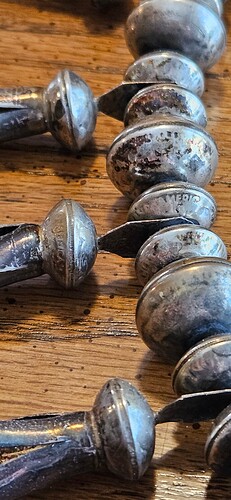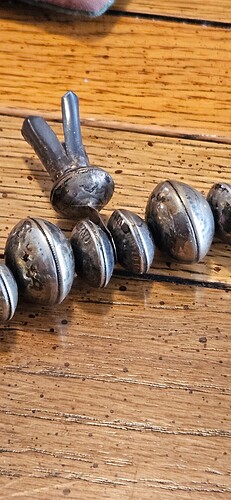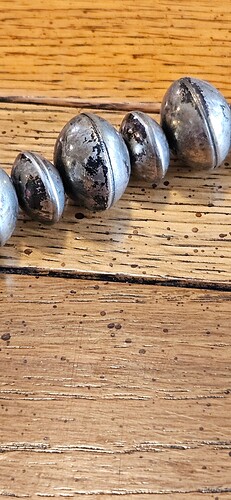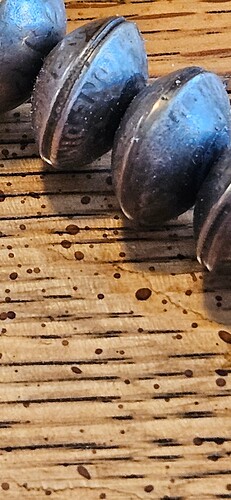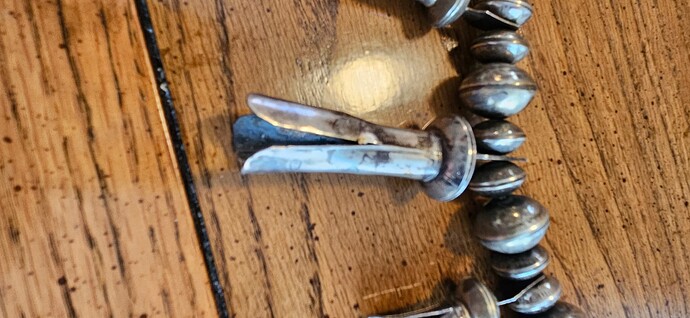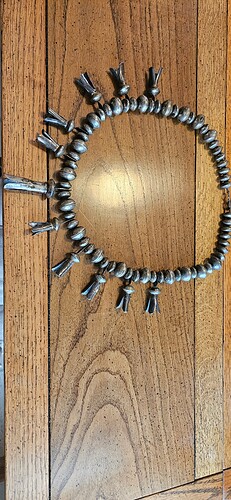We have a family piece, made of coin silver perhaps from the 20s? [EDIT: appears to be between 1946-1964 based on further info] Not much info on it, so again looking for any input you may have! It weighs about 20 oz.
There’s a difference between jewelry described as being made of “coin silver” and this set of vintage coins used to make the blossoms. Working from these pics, the saucer-shape beads have fairly crisp seaming versus being worn down and smooth, as you’d expect had they been used since the 20s. There are quite a few revival type necklaces out there (using older coins) dating from midcentury to the 1960s onward and still being made. Any chance you can add a pic featuring the bead holes?
You need a real history on this necklace to date it, plus testing of the metal to know more. How is it strung?
Thanks for that info, @chicfarmer! I will get additional pix later this week (the necklace and I are in different locations ![]() ). It is strung on wire. My father acquired it, understood it had been in a collection and was older. I’ll see what additional info I can turn up.
). It is strung on wire. My father acquired it, understood it had been in a collection and was older. I’ll see what additional info I can turn up.
Here’s what else I know about it. My mom unearthed the card! My father got it in the mid 90s. Thanks!
I see “dime” on the beads. Any dates visible.? A chain means it was likely restrung if older. The card dates it to c1946 the earliest. Are the larger beads quarters? The weight indicates vintage silver coinage.
@chicfarmer Thank you for that important clarification in the 1st sentence of your post.
Whatever the age, I really like it. It’s a partial squash (my term ![]() ) that I would actually wear!
) that I would actually wear!
It is quite heavy! We’ve had it lying in a case for 30 years ![]()
I will try for some detailed pix, and break out the magnifying glass!
A similar necklace for comparison…
https://www.schaefdesigns.com/turquoise_jewelry/mercury_dime_squash_blossom_n_enlarged.html
thank you. This one looks a lot more “polished” than the one we have, the blossoms are more refined, etc. I can’t see much coin face, but will look for dates on our example.
Your example is more what I am familiar with @TAH . My one concern was the excessive “wear” on all the coins. I’ve dealt with a lot of old silver coins and in my opinion it would take a concerted effort to find that many coins with what looks like similar wear patterns.
Here is info on Pat Read from the University of Kansas Kenneth Spencer Research Library Archival Collection that has a collection of Pat Read papers:
“Lieutenant Colonel Lathrop B. (Pat) Read Jr. (1897-1974) was a native of Lawrence, Kansas. After his retirement from the U.S. Army, Read became a nationally known dealer in Native American handicrafts - an “Indian Trader” as he was called - with shops in Lawrence, Kansas, and New Mexico. Read also traveled the United States promoting and lecturing on Native American cultures. This collection contains business records, correspondence, and clippings which reflect his activities as a dealer and lecturer.” Call Number: RH MS 843. Happy hunting!
Yeah, I wish those papers were digitized!
Because I’m learning, did any silversmiths intentionally smooth out coins when using them to make jewelry, so they were more a source of silver than a part of the design as coins?
I am not any kind of expert in coins in Native jewelry, but I have a Britwest leather cuff with old Indian head pennies, and the coins are pretty worn. Not as much as your piece, but more than in the one in Tah’s link. So I’m assuming they could maybe be just worn from use? The pennies on mine are dated late 1890’s and early 1900’s.
Edit: I see that @StevesTrail said similar wear. Thinking about that, the pennies on my cuff are very different in the amount of wear on each one.
I’m also a little confused because they’re not all the same size. Some are bigger. Not all dimes?
Based on silver dimes and quarter coin weights and allowing for the blossom weights, the necklace should weigh approximately 15.5 troy ounces. If it weighs 20 troy ounces the math does not add up.
Simply, revival pieces (made later in the style of earlier) sometimes use old coins, accounting for them looking old. Additionally, a variety of “antiquing” techniques are sometimes done for effect. It’s very possible to manage silverwork to closely reproduce the look of age, for sure creating problems in the marketplace.
I will say that saucer-shaped beads per se aren’t what you typically find in silver squash and bead necklaces of the1900-1920s era.
Oh, and last comment about the silver: sterling is one thing, coin is another, both can be heavy.
I’m enjoying all the discussion, thanks all. I did a rough weight since it’s too big for my pocket scale. I will look into having it assessed for content and get a better idea of weight.
I did find this info on a blog, which was of interest “Early Native American craftsmen made jewelry directly from the coins, heating the coins in a fire pit or forge and hammering them into shape. Items like this often have some faint residual impressions from the coin design remaining.” What does Coin Silver mean in relation to vintage Native American jewelry ? | Native American Jewelry Tips
We are not looking to sell right now, just getting more info before we liquidate our collection in the future. I’ll post more detailed pix when I can. Thanks all!
I’ve dapped coins. silver & copper,w/out heat,using wooden & steel tools. it’s not difficult (lol) but practice gets better results. haven’t tried to do a heavy/thick as a dollar cuz I just wasn’t interested.
